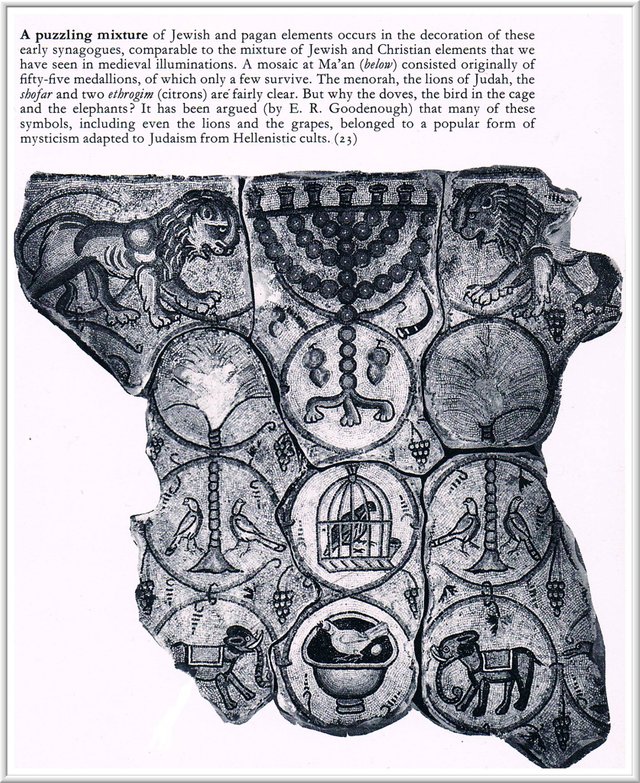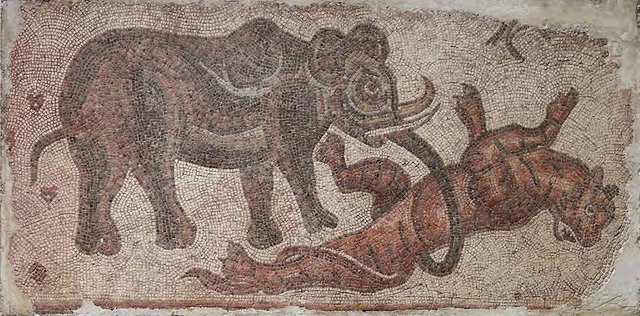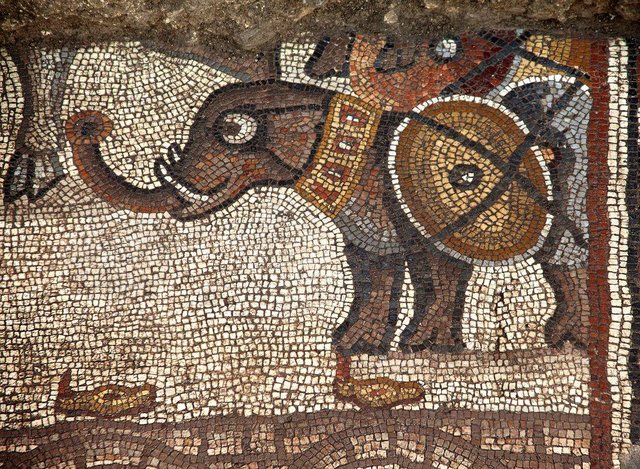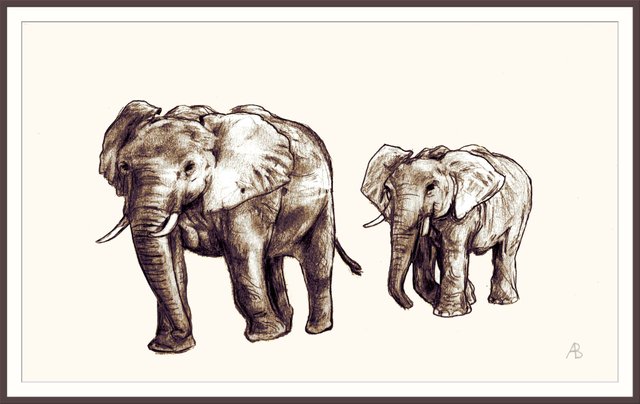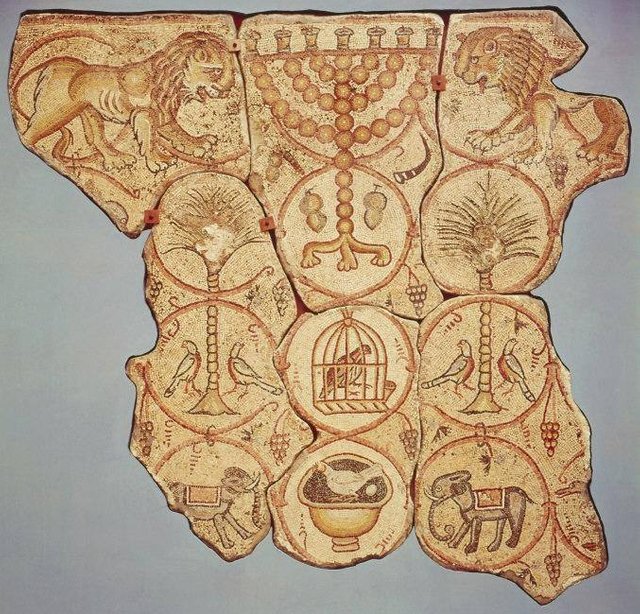The fragment of a foor mosaic at Ma'an depicting the elephants, similar to one in the Synagogue on the Elephantine island. The photos are from a book I forgot all about until it popped out in the archives. Scroll up to see the other pictures two separate posts, it took me a while to find them.
The picture shows the two alters, the elephants are matriarchal and so are the Babylonian Moseretic Jews, the opposite of the patriarchal Abrahamic tradition, and symbolize Yahweh Sabaoth (Lord God of Hosts) and his consort Asherah.
ASHERAH WIFE OF YAHWEH
Beginning during the Eighteenth Dynasty of Egypt, a Semitic goddess named Qetesh ("holiness", sometimes reconstructed as Qudshu) appears prominently. That dynasty follows expulsion of occupying foreigners from an intermediary period. Some think this deity is Athirat/Ashratu under her Ugaritic name. This Qetesh seems not to be either ʿAshtart or ʿAnat as both those goddesses appear under their own names and with quite different iconography, yet is called "Qudshu-Astarte-Anat" in at least one pictorial representation, aptly named the "Triple Goddess Stone".
Between the tenth century BC and the beginning of their Babylonian exile in 586 BC, polytheism was normal throughout Israel. Worship solely of Yahweh became established only after the exile, and possibly, only as late as the time of the Maccabees (2nd century BC). That is when monotheism became universal among the Jews. Some biblical scholars believe that Asherah at one time was worshipped as the consort of Yahweh, the national God of Israel.
There are references to the worship of numerous deities throughout the Books of Kings: Solomon builds temples to many deities and Josiah is reported as cutting down the statues of Asherah in the temple Solomon built for Yahweh (2 Kings 23:14). Josiah's grandfather Manasseh had erected one such statue (2 Kings 21:7).
Further evidence for Asherah-worship includes, for example, an eighth-century BC combination of iconography and inscriptions discovered at Kuntillet Ajrud in the northern Sinai desert where a storage jar shows three anthropomorphic figures and several inscriptions. The inscriptions found refer not only to Yahweh but to ʾEl and Baʿal, and two include the phrases "Yahweh of Samaria and his Asherah" and "Yahweh of Teman and his Asherah." The references to Samaria (capital of the kingdom of Israel) and Teman (in Edom) suggest that Yahweh had a temple in Samaria, while raising questions about the relationship between Yahweh and Kaus, the national god of Edom.
The 'asherah' in question is most likely a cultic object, although the relationship of this object (a stylised tree perhaps) to Yahweh and to the goddess Asherah, consort of ʾEl, is unclear. It has been suggested that the Israelites may have considered Asherah as the consort of Baʿal, due to the anti-Asherah ideology that was influenced by the Deuteronomistic Historians, at the later period of the kingdom.
Also, it has been suggested by several scholars that there is a relationship between the position of the gəḇīrā in the royal court and the worship (orthodox or not) of Asherah. In a potsherd inscription of blessings from "Yahweh and his Asherah", there appears a cow feeding its calf. Numerous Canaanite amulets depict a woman wearing a bouffant wig similar to the Egyptian Hathor. If Asherah is then to be associated with Hathor/Qudshu, it can then be assumed that the cow is being referred to as Asherah.
HOLY COW
Bull worship was common in many cultures. In Egypt, whence according to the Exodus narrative the Hebrews had recently come, the Apis Bull was a comparable object of worship, which some believe the Hebrews were reviving in the wilderness; alternatively, some believe Yahweh, the national god of the Israelites, was associated with or pictured as a calf/bull deity through the process of religious assimilation and syncretism. Among the Canaanites, some of whom would become the Israelites, the bull was widely worshipped as the Lunar Bull and as the creature of El. Therefore the Golden Calf could have been serving dual purpose as the representation of both Yahweh and Asherah.
ARCHEOLOGICAL EVIDENCE
William Dever's book Did God Have a Wife? adduces further archaeological evidence—for instance, the many female figurines unearthed in ancient Israel, (known as pillar-base figurines)—as supporting the view that during Israelite folk religion of the monarchical period, Asherah functioned as a goddess and a consort of Yahweh and was worshiped as the queen of heaven, for whose festival the Hebrews baked small cakes. Dever also points to the discovery of multiple shrines and temples within ancient Israel and Judah.
The temple site at Arad is particularly interesting for the presence of two (possibly three) massebot, standing stones representing the presence of deities. Although the identity of the deities associated with the massebot is uncertain, Yahweh and Asherah or Asherah and Baal remain strong candidates, as Dever notes: "The only goddess whose name is well attested in the Hebrew Bible (or in ancient Israel generally) is Asherah."
THE BIBLE
The name Asherah appears forty times in the Hebrew Bible, but it is much reduced in English translations. The word ʾăšērâ is translated in Greek as Greek: ἄλσος (grove; plural: ἄλση) in every instance apart from Isaiah 17:8; 27:9 and 2 Chronicles 15:16; 24:18, with Greek: δένδρα (trees) being used for the former, and, peculiarly, Ἀστάρτη (Astarte) for the latter. The Vulgate in Latin provided lucus or nemus, a grove or a wood. From the Vulgate, the King James translation of the Bible uses grove or groves instead of Asherah's name. Non-scholarly English language readers of the Bible would not have read her name for more than 400 years afterward.
The association of Asherah with trees in the Hebrew Bible is very strong. For example, she is found under trees (1 Kings 14:23; 2 Kings 17:10) and is made of wood by human beings (1 Kings 14:15, 2 Kings 16:3–4). Trees described as being an asherah or part of an asherah include grapevines, pomegranates, walnuts, myrtles, and willows.
KABBALAH
Shekhinah as Feminine Aspect
Kabbalah associates the shekhinah with the female. According to Gershom Scholem, "The introduction of this idea was one of the most important and lasting innovations of Kabbalism. ...no other element of Kabbalism won such a degree of popular approval." The "feminine Jewish divine presence, the shekhinah, distinguishes Kabbalistic literature from earlier Jewish literature."
YAHWEH SABAOTH
OLD TESTAMENT
In the Hebrew Bible, the name Yahweh and the title Elohim (literally 'gods', usually rendered as 'God' in English translations) frequently occur with the word tzevaot or sabaoth ("hosts" or "armies", Hebrew: צבאות) as YHWH Elohe Tzevaot ("YHWH God of Hosts"), Elohe Tzevaot ("God of Hosts"), Adonai YHWH Tzevaot ("Lord YHWH of Hosts") or, most frequently, YHWH Tzevaot ("YHWH of Hosts"). This name is traditionally transliterated in Latin as Sabaoth, a form that will be more familiar to many English readers, as it is used in the King James Version of the Bible.
NEW TESTAMENT
In the Book of Revelation, the rebellious forces of Satan are defeated by the heavenly host led by Michael the Archangel during the War in Heaven (Rev.12:7–9).
BAHA'I FAITH
The term "Lord of Hosts" is also used in the Baháʼí Faith as a title of God. Bahá'u'lláh, claiming to be the Manifestation of God, wrote tablets to many of the kings and rulers of the world inviting them to recognize him as the Promised One of all ages and faiths, some of which were compiled and published in English as The Summons of the Lord of Hosts.
GANESHA
Although Ganesha has many attributes, he is readily identified by his elephant head. He is widely revered, more specifically, as the remover of obstacles and thought to bring good luck; the patron of arts and sciences; and the deva of intellect and wisdom.
GOD OF THE BEGINNINGS
As the god of beginnings, he is honored at the start of rites and ceremonies. Ganesha is also invoked as a patron of letters and learning during writing sessions. Several texts relate mythological anecdotes associated with his birth and exploits.
An elephant–headed anthropomorphic figure on Indo-Greek coins from the 1st century BCE has been proposed by some scholars to be "incipient Ganesha", while others have suggested Ganesha may have been an emerging deity in India and southeast Asia around the 2nd century CE based on the evidence from archaeological excavations in Mathura and outside India.
Most certainly by the 4th and 5th centuries CE, during the Gupta period, Ganesha was well established and had inherited traits from Vedic and pre-Vedic precursors. Hindu mythology identifies him as the restored son of Parvati and Shiva of the Shaivism tradition, but he is a pan-Hindu god found in its various traditions.
In the Ganapatya tradition of Hinduism, Ganesha is the supreme deity. The principal texts on Ganesha include the Ganesha Purana, the Mudgala Purana and the Ganapati Atharvasirsha. Brahma Purana and Brahmanda Purana are other two Puranic genre encyclopaedic texts that deal with Ganesha.
THE ELEPHANTINE ISLAND SYNAGOGUE
The Elephantine papyri are caches of legal documents and letters written in Aramaic dating to sometime in the 5th century BC. These papyri document the presence starting in the 7th century BCE of a community of Judean mercenaries and their families on Elephantine who guarded the frontier between Egypt and Nubia to the south.
Following the Babylonian destruction of Jerusalem in the 6th century BCE, some Judean refugees traveled south and, in what may be called an “exodus in reverse,” settled on Elephantine. They maintained their own temple (also see House of Yahweh), in which sacrifices were offered, evincing polytheistic beliefs, which functioned alongside that of Khnum. The temple was destroyed in 410 BC at the instigation of the priests of Khnum.
The temple may have been built in reaction to Manasseh's reinstitution of pagan worship or simply to serve the needs of the Jewish community. Interesting to note is that Manasseh and his son Amon are mentioned in the genealogy of Jesus in Matthew's gospel.
♡
_ \ \ | / / _
